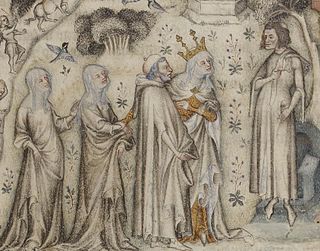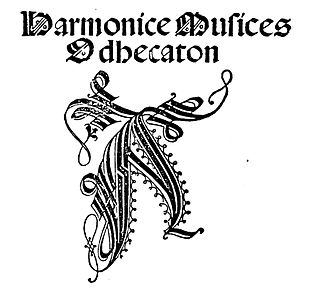Related Research Articles

Renaissance music is traditionally understood to cover European music of the 15th and 16th centuries, later than the Renaissance era as it is understood in other disciplines. Rather than starting from the early 14th-century ars nova, the Trecento music was treated by musicology as a coda to Medieval music and the new era dated from the rise of triadic harmony and the spread of the contenance angloise style from Britain to the Burgundian School. A convenient watershed for its end is the adoption of basso continuo at the beginning of the Baroque period.

Guillaume de Machaut was a French composer and poet who was the central figure of the ars nova style in late medieval music. His dominance of the genre is such that modern musicologists use his death to separate the ars nova from the subsequent ars subtilior movement. Regarded as the most significant French composer and poet of the 14th century, he is often seen as the century's leading European composer.
Ottaviano Petrucci was an Italian printer. His Harmonice Musices Odhecaton, a collection of chansons printed in 1501, is commonly misidentified as the first book of sheet music printed from movable type. Actually that distinction belongs to the Roman printer Ulrich Han's Missale Romanum of 1476. Nevertheless, Petrucci's later work was extraordinary for the complexity of his white mensural notation and the smallness of his font, and he did in fact print the first book of polyphony using movable type. He also published numerous works by the most highly regarded composers of the Renaissance, including Josquin des Prez and Antoine Brumel.

The rondo is a musical form that contains a principal theme which alternates with one or more contrasting themes, generally called "episodes", but also occasionally referred to as "digressions" or "couplets". Some possible patterns include: ABACA, ABACAB, ABACBA, or ABACABA.
The ballade is a form of medieval and Renaissance French poetry as well as the corresponding musical chanson form. It was one of the three formes fixes and one of the verse forms in France most commonly set to music between the late 13th and the 15th centuries.

Guillaume Du Fay was a composer and music theorist of early Renaissance music, who is variously described as French or Franco-Flemish. Considered the leading European composer of his time, his music was widely performed and reproduced. Du Fay was well-associated with composers of the Burgundian School, particularly his colleague Gilles Binchois, but was never a regular member of the Burgundian chapel himself.
A chanson is generally any lyric-driven French song. The term is most commonly used in English to refer either to the secular polyphonic French songs of late medieval and Renaissance music or to a specific style of French pop music which emerged in the 1950s and 1960s. The genre had origins in the monophonic songs of troubadours and trouvères, though the only polyphonic precedents were 16 works by Adam de la Halle and one by Jehan de Lescurel. Not until the ars nova composer Guillaume de Machaut did any composer write a significant number of polyphonic chansons.
A lai is a lyrical, narrative poem written in octosyllabic couplets that often deals with tales of adventure and romance. Lais were mainly composed in France and Germany, during the 13th and 14th centuries. The English term lay is a 13th-century loan from Old French lai. The origin of the French term itself is unclear; perhaps it is itself a loan from German Leich (reflected in archaic or dialectal English lake, "sport, play" and in modern Swedish. The terms note, nota and notula appear to have been synonyms for lai.

The Burgundian School was a group of composers active in the 15th century in what is now northern and eastern France, Belgium, and the Netherlands, centered on the court of the Dukes of Burgundy. The school inaugurated the music of Burgundy.

Antoine Busnois was a French composer, singer and poet of early Renaissance music. Busnois and colleague Johannes Ockeghem were the leading European composers of the second half the 15th century, and central figures of the early Franco-Flemish School.

Loyset Compère was a Franco-Flemish composer of the Renaissance. Of the same generation as Josquin des Prez, he was one of the most significant composers of motets and chansons of that era, and one of the first musicians to bring the light Italianate Renaissance style to France.
A virelai is a form of medieval French verse used often in poetry and music. It is one of the three formes fixes and was one of the most common verse forms set to music in Europe from the late thirteenth to the fifteenth centuries.
Nicolas Grenon was a French composer of the early Renaissance. He wrote in all the prevailing musical forms of the time, and was a rare case of a long-lived composer who learned his craft in the late 14th century but primarily practiced during the era during which the Renaissance styles were forming.
A rondeau is a form of medieval and Renaissance French poetry, as well as the corresponding musical chanson form. Together with the ballade and the virelai it was considered one of three formes fixes, and one of the verse forms in France most commonly set to music between the late 13th and the 15th centuries. It is structured around a fixed pattern of repetition of verse with a refrain. The rondeau is believed to have originated in dance songs involving singing of the refrain by a group alternating with the other lines by a soloist. The term "Rondeau" is used both in a wider sense, covering older styles of the form which are sometimes distinguished as the triolet and rondel, and in a narrower sense referring to a 15-line style which developed from these forms in the 15th and 16th centuries. The rondeau is unrelated to the much later instrumental dance form that shares the same name in French baroque music, which is more commonly called the rondo form in classical music.
Solage, possibly Jean So(u)lage, was a French composer, and probably also a poet. He composed the most pieces in the Chantilly Codex, the principal source of music of the ars subtilior, the manneristic compositional school centered on Avignon at the end of the century.

The Harmonice Musices Odhecaton is an anthology of polyphonic secular songs published by Ottaviano Petrucci in 1501 in Venice. It is the first book of polyphonic music ever to be printed using movable type. The Odhecaton was hugely influential both in publishing in general and in dissemination of the Franco-Flemish musical style.
Pierre Fontaine was a French composer of the transitional era between the late Middle Ages and early Renaissance, and a member of the Burgundian School of composers. While he was well known at the time, most of his music has probably been lost. All of his surviving music is secular, and all his compositions are chansons.

Grimace was a French composer-poet in the ars nova style of late medieval music. Virtually nothing is known about Grimace's life other than speculative information based on the circumstances and content of his five surviving compositions of formes fixes; three ballades, a virelai and rondeau. His best known and most often performed work in modern-times is the virelai and proto-battaglia: A l’arme A l’arme.

Adieu mes amours was a popular secular polyphonic chanson of the late 15th century. Many settings of this tune are in fact based on the c. 1480 setting by Josquin des Prez, in which the lower two voices are in quasi-canon, and the upper two voices are freer. The tune itself is in a simple ABA' form. It appeared in many manuscripts and prints from many countries, including in Ottaviano Petrucci's Odhecaton A.
Guillaume Legrant was a French composer of the early Renaissance, active in Flanders, Italy, and France. He was one of the first composers in writing polyphony to distinguish between passages for solo and multiple voices on each part.
References
- ↑ Henri Louis Chatelain Recherches sur le vers français au XVe siècle: rimes, mètres et ... 1908 p197 "Le virelai n'est plus alors que la bergerette, c'est-à-dire un rondeau, dont le deuxième élément est sur d'autres ... Charles d'Orléans a laissé une pièce qui réunit les caractères du rondeau et de la bergerette"
- ↑ The Chansonnier El Escorial IV.a.24 Real Biblioteca, Martha K. Hanen - 1983 "The Virelai Texts - A virelai text which has but a single stanza is properly termed a bergerette. All the virelais in Escorial IV.a.24 have single-stanza or bergerette texts. Since the music for a virelai is exactly the same as that for a ..."
- ↑ Music Literature Outline 1: Outline 1, Middle Ages and Renaissance p96 Harold Gleason, Warren Becker, Catherine C. Gleason - 1988 "Chanson is a generic term and includes the formes fixes: rondeau, virelai, ballade and bergerette. ... The bergerette, developed by Burgundian composers, is similar to the virelai but with only one stanza.
- ↑ Journal of the American Musicological Society , Vol.41, American Musicological Society - 1988 "... untexted pieces in Q 18 can be placed, with a certain degree of overlap, in various categories. A number are based on vocal models, relying loosely on the structure of the formes fixes, particularly the rondeau or bergerette."
- ↑ Harmonice musices odhecaton A printer Ottaviano Petrucci, ed Helen Hewitt, Isabel Pope - 1978 "The Odhecaton and Brux 1 show complete bergerette music, ie, musical sections, a and p. Brux 1 also gives words of ... There seems little reason to doubt that the original form of the composition was the 'long' form, or, bergerette."